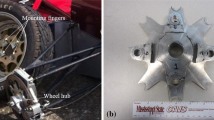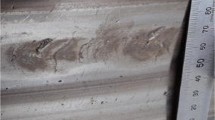Keeping the weight of unsprung rotating components low is critical for fuel efficiency in automobiles; therefore, cast aluminum alloys are the current material of choice for wheels. However, pores formed during solidification can combine with residual stresses and in-service loads to reduce the fatigue life of this safety critical part. In this study, a model of the residual stresses arising from the quench stage of a T6 heat treatment was developed. The resulting predictions were compared to residual strain measurements made on quenched wheels via a strain gage/sectioning technique. The predictions were shown to be sensitive to the alloy’s flow stress behavior, yet no data were available for the temperature- dependent and strain-rate-dependent inelastic behavior of A356 in the as-solutionized condition. Measurements of this behavior were made using a GLEEBLE 3500, and the data were incorporated into the model, significantly improving the correlation between model and experiment. In order to determine the influence of residual stress upon the final fatigue performance of the wheel during service, the change in stress level due to machining was first calculated. The residual stress was then compounded together with a service stress to determine the local stress at all points in the wheel during idealized operation. Finally, the fatigue behavior was predicted using a unified initiation and propagation model based on this local stress and an idealized pore size.
Similar content being viewed by others
References
Li P., Lee P.D., Lindley T.C., Maijer D.M., Davis G.R. and Elliott J.C. (2006). Adv. Eng. Mater. 8: 476–79
Wang Q.G., Apelian D. and Lados D.A. (2001). J. Light Met 1: 73–84
Yi J.Z., Gao Y.X., Lee P.D., Flower H.M. and Lindley T.C. (2003). Metall. Mater. Trans. A 34: 1879–90
Maijer D.M., Gao Y., Lee P.D., Lindley T.C. and Fukui T. (2004). Metall. Mater. Trans. A 35: 3275–88
Robinson J.S. and Tanner D.A. (2003). Mater. Sci. Technol. 19: 512–18
Kermanpur A., Tin S., Lee P.D. and McLean M. (2004). JOM 56: 72–78
Tin S., Lee P.D., Kermanpur A., Rist M. and McLean M. (2005). Metall. Mater. Trans. A 36: 2493–504
European FP5 Programs G5RD-CT-2000-00153, 1999, http://www.eaa. net/downloads/virprojects.pdf.
Gur C.H. and Tekkaya A.E. (2001). Mater. Sci. Eng. A 319–21: 164–69
Tanner D.A. and Robinson J.S. (2000). Exper. Mech. 40: 75–82
Tanner D.A. and Robinson J.S. (2003). Finite Elem. Anal. Des. 39: 369–86
Dye D., Conlon K.T. and Reed R.C. (2004). Metall. Mater. Trans. A 35: 1703–13
Estey C.M., Cockcroft S.L., Maijer D.M. and Hermesmann C. (2004). Mater. Sci. Eng., A 383: 245–51
Mills K.C. (2002). Recommended Values of Thermophysical Properties for Selected Commercial Alloys. Woodhead Publishing Limited, Cambridge, United Kingdom, 43–49
C.M. Estey, Master’s Thesis, University of British Columbia, Vancouver, 2004.
Bamberger M. and Prinz B. (1986). Mater. Sci. Technol. 2: 410–15
Yi J.Z., Gao Y.X., Lee P.D. and Lindley T.C. (2004). Mater. Sci. Eng., A 386: 396–407
M.J. Caton, J.W. Jones, and J.E. Allison: in Fatigue Crack Growth Thresholds, Endurance Limits, and Design, ASTM STP 1732, J.C. Newman, Jr. and R.S. Piascik, eds., ASTM, West Conshohocken, PA, 2000, pp. 285-303.
Gao Y.X., Yi J.Z., Lee P.D. and Lindley T.C. (2004). Acta Mater. 52: 5435–49
Kocks U.F. and Mecking H. (2003). Progr. Mater. Sci. 48: 171–273
Osorio W.R., Santos C.A., Quaresma J.M.V. and Garcia A. (2003). J. Mater. Proc. Technol. 143(144): 703–09
H.R. Voorhees and J.W. Freeman: Report on the Elevated-Temperature Properties of Aluminum and Magnesium Alloys, ASTM, Philadelphia, PA, 1960, pp. 217-24.
Lee P.D., Chirazi A., Atwood R.C. and Wang W. (2004). Mater. Sci. Eng., A 365: 57–65
Lee P.D. and Hunt J.D. (1997). Acta Mater. 45: 4155–69
Author information
Authors and Affiliations
Corresponding author
Additional information
This article is based on a presentation made in the symposium “Simulation of Aluminum Shape Casting Processing: From Design to Mechanical Properties,” which occurred March 12-16, 2006, during the TMS Spring Meeting in San Antonio, Texas, under the auspices of the Computational Materials Science and Engineering Committee, the Process Modeling, Analysis and Control Committee, the Solidification Committee, the Mechanical Behavior of Materials Committee, and the Light Metal Division/Aluminum Committee.
Rights and permissions
About this article
Cite this article
Li, P., Maijer, D.M., Lindley, T.C. et al. Simulating the Residual Stress in an A356 Automotive Wheel and Its Impact on Fatigue Life. Metall Mater Trans B 38, 505–515 (2007). https://doi.org/10.1007/s11663-007-9050-5
Published:
Issue Date:
DOI: https://doi.org/10.1007/s11663-007-9050-5




